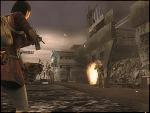Reviews// Mercenaries: Playground of Destruction (Xbox)
I see your sniper and raise one carpet-bomb
It would be wrong to suggest that Mercenaries is about being a scaredy-cat though, because there’s plenty of scope for the fiercest braves. Tackling your targets can be done in a wide variety of ways through numerous approaches. Often you can complete a mission in fairly straight forward fashion, killing anyone dangerous looking and chucking grenades about the place, but there’s arguably more fun to be had by taking a more radical strategy. Stealth fans will be pleased by the opportunities for covert ops, and sniping from mountain-tops is as smugly satisfying as it ever could be. You can disguise yourself by stealing (or purchasing) the relevant military or civilian vehicle, and then perhaps unload a vanful of allied soldiers in a Chinese base, Trojan Horse style. But best of all is the other extreme, dispensing with stealth and going with massive, unjustifiable overkill.
The variety of weaponry in Mercenaries invites an obscenely destructive approach for those so inclined. There’s a plethora of ‘shock and awe’ style air-strike options and a spread of extremely heavy duty explosives to make use of, and the enormous resulting explosions are absolutely fantastic. Perhaps your particular mission is to track down and kill a particular individual you know to be hiding in a certain part of town. In which case, you can pretty much destroy the entire town. Drop a few carpet bombs, launch a tank assault on a skyscraper, blow up any remaining structures and then hover above the razed rubble sniping anything with the nerve to twitch even slightly. If Mercenaries is described as a ‘sand-pit’ game, then it’s only because you’ve already stomped all over those nicely designed sandcastles that were there in the beginning.
Unlike certain other 'playground' style games, Mercenaries manages to get by without much emphasis on the storyline, and it has had criticism levelled at it because of this. However, in this instance, the lack of rigid storyline seems to have been the most appropriate way to do things. The underlying storyline is simply that there’s a war going on outside, and that’s about as structured as it probably should be. The rest of the storyline, because you can keep switching sides, is largely of your own making. Whilst players who like to have their hand held throughout the entire course of a game might find this slightly alarming, we found it all the more satisfying. The basic premise is linear enough to understand what needs to be done, so there’s never the feeling that you might be lost; but outside of these basic parameters, you can pretty much do as you choose. To maintain progress, you need to capture various individuals that make up a deck of ‘wanted’ playing cards, but the way in which the faction mission are interweaved is almost entirely up to the player’s preference.
The variety of weaponry in Mercenaries invites an obscenely destructive approach for those so inclined. There’s a plethora of ‘shock and awe’ style air-strike options and a spread of extremely heavy duty explosives to make use of, and the enormous resulting explosions are absolutely fantastic. Perhaps your particular mission is to track down and kill a particular individual you know to be hiding in a certain part of town. In which case, you can pretty much destroy the entire town. Drop a few carpet bombs, launch a tank assault on a skyscraper, blow up any remaining structures and then hover above the razed rubble sniping anything with the nerve to twitch even slightly. If Mercenaries is described as a ‘sand-pit’ game, then it’s only because you’ve already stomped all over those nicely designed sandcastles that were there in the beginning.
Unlike certain other 'playground' style games, Mercenaries manages to get by without much emphasis on the storyline, and it has had criticism levelled at it because of this. However, in this instance, the lack of rigid storyline seems to have been the most appropriate way to do things. The underlying storyline is simply that there’s a war going on outside, and that’s about as structured as it probably should be. The rest of the storyline, because you can keep switching sides, is largely of your own making. Whilst players who like to have their hand held throughout the entire course of a game might find this slightly alarming, we found it all the more satisfying. The basic premise is linear enough to understand what needs to be done, so there’s never the feeling that you might be lost; but outside of these basic parameters, you can pretty much do as you choose. To maintain progress, you need to capture various individuals that make up a deck of ‘wanted’ playing cards, but the way in which the faction mission are interweaved is almost entirely up to the player’s preference.
Read More Like This
Comments
Picking sides and having opposing factions getting a little annoyed at you actions was a great feature in GTA2. It something that I was surprised to see missing from more recent GTA games, with only a set of scripted allegiances catered for.
Mercenaries does sound like fun, so I reckon I'll have to give this a try.
Mercenaries does sound like fun, so I reckon I'll have to give this a try.
This does sound cool enough to buy and along the lines of Freedom Fighters, which I loved and eagerly awaiting the sequel. Mercs PoD sounds like just the ticket to keep me busy next to RE4 and Shadow of Rome.



